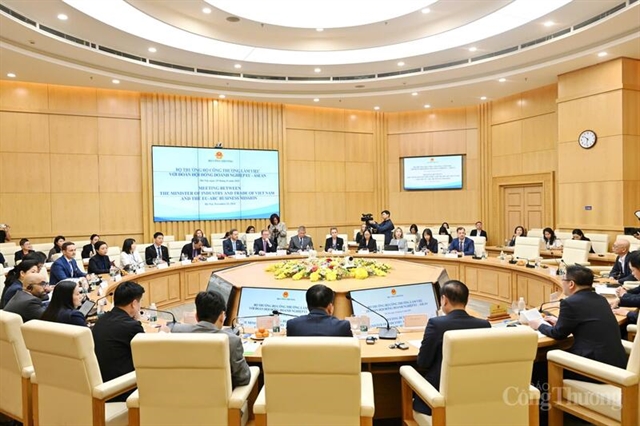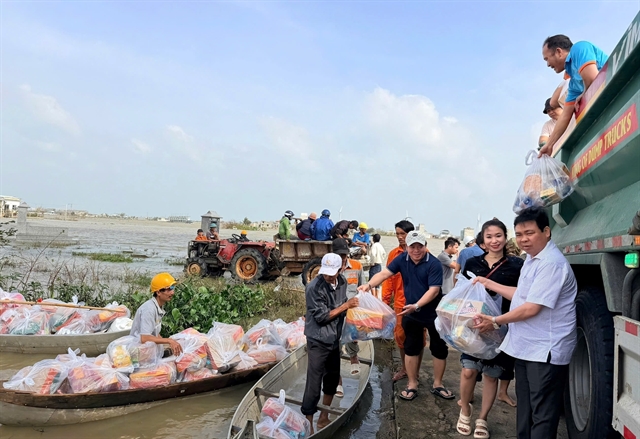 Economy
Economy

Việt Nam’s rice exports surged this year to 1.29 million tonnes worth US$602 million by mid-March, 26.5 per cent and 34.6 per cent up.

|
| Lê Thanh Tùng, deputy director of the Department of Crop Production under the Ministry of Agriculture and Rural Development. — VNS Photo Xuân Hương |
Việt Nam’s rice exports surged this year to 1.29 million tonnes worth US$602 million by mid-March, 26.5 per cent and 34.6 per cent up.
Despite drought, saltwater intrusion and unfavourable weather, the country managed to grow enough rice for both domestic consumption and export.
Lê Thanh Tùng, deputy director of the Ministry of Agriculture and Rural Development’s Department of Crop Production, speaks to Việt Nam News about this issue.
The Cửu Long (Mekong) Delta, the country’s rice bowl, is facing historic saltwater intrusion and drought. How are they affecting agricultural production?
It is not just this year that agriculture in the region has faced drought, saltwater intrusion or extreme weather.
In 2011 the historic flood affected 5,000ha of autumn-winter rice in the region. The historic drought and saltwater intrusion in 2015-16 damaged 150,000ha of rice.
[These] persuaded agricultural agencies under the direction of the Ministry of Agriculture and Rural Development and localities in the region to make comprehensive preparations to cope with these new situations to sustain rice and fruit production in the region.
Drought and saline intrusion in 2019-20 are different and more severe than in 2015-16, but thanks to early forecast and better preparations such as encouraging farmers to sow the winter-spring rice crop one month earlier than they normally do, the loss is lower than in 2015-16.
Thirty thousand hectares of rice have been affected and about 20,000ha have been damaged this year compared to 450,000ha affected and 150,000ha damaged in 2015-16.
While exports of other agricultural goods fell sharply due to the impact of the Covid-19 pandemic, rice exports grew sharply in the first two months of the year. What do you attribute the situation to?
There are two factors. Firstly, unlike in previous years, when companies signed export contracts to sell rice harvested from the winter-spring crop with delivery after February, this year farmers sowed the winter-spring rice crop earlier than in previous years, and so the harvest was also earlier. Therefore enterprises signed the contract and shipped it to their partners earlier than in previous years.
Secondly, the Covid-19 pandemic has prompted many countries to stock up on rice.
With high demand due to Covid-19, rice export prices can remain high from now until the end of the year.
The other issue is businesses need to know when farmers harvest their paddy to sign export contracts and how to create profits for everyone involved in the rice value chain.
We currently export rice to many countries, and this year we will have an advantage in exporting the grain to the EU [thanks to the EU-Việt Nam Free Trade Agreement to come into force].
We have more rice varieties than Thailand or Cambodia. We have low-grade, average-grade, high-grade, speciality, and organic rice. This is an advantage for us since we can meet all kinds of customers’ needs.
An issue of great concern to many people is that with global rice demand increasing sharply, will our production meet both domestic and export needs? What is your view on this?
The country annually produces about 43 million tonnes of paddy on average. Of this, the Mekong Delta accounts for more than 50 per cent, or 24-25 million tonnes. Rice production in other regions such as the Red River Delta and the northern and south-eastern regions can balance the food supply and demand within the region.
With an annual output of 24-25 tonnes of paddy, which is equivalent to 12-13 million tonnes of rice, the Mekong Delta, besides ensuring rice supply for its 18 million population and the 12 million in HCM City, still has nearly 6.5-7 million tonnes for export.
With the current unfavourable weather, we will have around six million tonnes this year.
In the next 10 to 20 years, with the population growth rate, rice productivity and cultivation areas as they are now, we will still have around five million tonnes for export annually.
Việt Nam is resolute about retaining its arable lands, especially in the Mekong and Red River deltas, to avoid repeating the mistakes made by some other countries. We know that if we go from being a self-sufficient country, even a rice export country, to a country with a food shortage, it will be hard to recoup that status.
Amid the increasing global demand for rice, does the Ministry of Agriculture and Rural Development plan to expand the area under rice to meet the rising demand?
This year we set a target of producing 43 million tonnes of paddy and setting aside 6-6.5 million tonnes of rice for exports.
We plan to increase the area under the autumn-winter rice by 50,000ha, but we must wait for three more months when the summer-autumn crop nears its harvest period to evaluate the upstream flood, rainfall and local irrigation systems, and then we will decide whether to encourage farmers to expand the cultivation area or not.
If we increase the cultivation area, we will increase it by only 50,000ha because anything more will be very risky. — VNS




